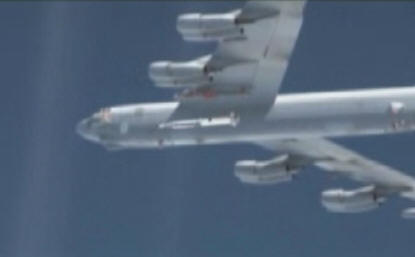|
|||||||||||
|
|
|
|||
|
By Bill Goldston |
||||
 |
May 27, 2010 - In its first flight attempt, the Boeing X-51A WaveRider today successfully completed the longest supersonic combustion ramjet-powered flight in history nearly three and a half minutes at a top speed of Mach 5.
The unmanned
aerial vehicle was released from a U.S. Air Force B-52H bomber off the
southern It flew autonomously for more than 200 seconds, powered by its Pratt & Whitney Rocketdyne supersonic combustion ramjet (scramjet) motor, as it transmitted telemetry data to ground stations. Something then occurred that caused the vehicle to lose acceleration. At that point, the X-51A was terminated as planned. |
|||
|
|
||||
|
"The technology proven today is something The Boeing Company has worked on for the past seven years," said Alex Lopez, vice president of Advanced Network & Space Systems, a division of Boeing Phantom Works. "It is thrilling to be a part of history and advance hypersonic science to the next level. Boeing is looking forward to transitioning the technology to operation in the near term, but for now, we are exhilarated." Even before analyzing the terabytes of telemetry data transmitted by the X-51A during flight, Air Force officials called the test an unqualified success.
"We are ecstatic
to have accomplished many of the X-51A test points during its first
hypersonic mission," said Charlie Brink, X-51A program manager with the
Air Force Research Laboratory at Wright-Patterson Air Force Base,
The X-51A was
carried aloft under the left wing of an Air Force Flight Test Center
B-52H Stratofortress that took off from Edwards Air Force Base. It was
released while flying at approximately 50,000 feet over the |
||||
|
Onboard sensors transmitted data to both an airborne U.S. Navy P-3 Orion and to ground systems at Point Mugu, Edwards, and Vandenberg Air Force Base before the X-51A was terminated. The team will review the data from today's test before scheduling additional flights with the three remaining test vehicles. "This is a new world record and sets the foundation for several hypersonic applications, including access to space, reconnaissance, strike, global reach and commercial transportation," said Joe Vogel, Boeing director of Hypersonics and X-51A program manager.
Boeing Phantom
Works, a division of Boeing Defense, Space & Security, performed the
overall air vehicle design, assembly and testing for the X-51A's various
components. The X-51A program is a collaborative effort of the Air Force
Research Laboratory and the Defense Advanced Research Projects Agency,
with industry partners Boeing and Pratt & Whitney Rocketdyne.
Program officials
noted that while development of the vehicle's engine and the test
program are complex, controlling costs has been a key objective. The
team has adapted existing proven technologies and elected not to build
recovery systems into the flight test vehicles. |
| Other News Stories |
|
|
| ?AvStop
Online Magazine
Contact
Us
Return To News
|
|


